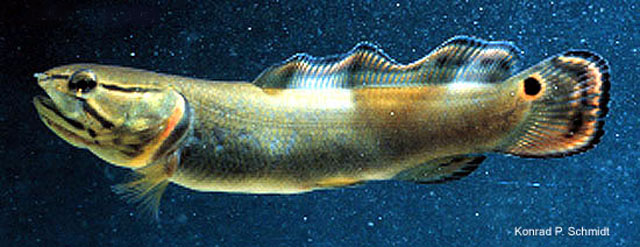| Amiidae (Bowfins) |
| 109 cm TL (male/unsexed); max.weight: 9,750.0 g; max. reported age: 30 years |
|
demersal; freshwater |
| North America: St. Lawrence River - Great Lakes and Mississippi River basins from Quebec in Canada to northern Minnesota and south to Gulf, and on Atlantic and Gulf coastal plains from Susquehanna River drainage in southeastern Pennsylvania, to Colorado River in Texas, USA. Introduced sparingly elsewhere, including on Atlantic Slope north to Massachusetts, USA. |
|
Dorsal spines (total): 0-0; Dorsal soft rays (total): 42-53; Anal spines: 0-0; Anal soft rays: 9-12; Vertebrae: 80-90. Branchiostegal rays: 10-12. Body is long and robust. Head is conic, mouth large, with maxillary extending well past eye; jaws wit strong, conical teeth; anterior nostrils at base of short barbels. Dorsal fin origin at 1/3 of total length; anal fin origin at midpoint of dorsal base; pelvic fins inserted at midpoint of body.
Pigmentation: Dark olive above combines with lighter color on sides to form reticulated pattern; venter cream or greenish; head yellow to brown with darker horizontal bars; lower fins vivid green; caudal light olive with irregular darker vertical bars. Adult males with prominent yellow to orange bordered black spot at upper caudal base, less intense or absent in females. |
| It inhabits swamps, sloughs, lakes, and pools and backwaters of lowland streams (Ref. 86798). It is usually found near vegetation (Ref. 86798). Air-breather that can withstand high temperatures, which enables it to survive in stagnant areas; even known to aestivate; lethal temperature is 35.2°C (Ref. 46234). A voracious and opportunist feeder, subsisting on fishes including other sport fishes, frogs, crayfish, insects, and shrimps. It uses scent as much as sight and captures food by means of gulping water. Small juveniles eat microcrustaceans and insects (Ref. 93252). Males are always smaller than females which live longer. Apparently somewhat migratory during spawning season (Ref. 4639). Eggs are adhesive, attached to decaying vegetation and upright weeds (Ref. 4639). Larvae are found in nest, remaining attached to roots or lying on bottom until adhesive organ is absorbed, thereafter in tight "swarm" guarded by male parent outside nest (Ref. 4639). A 'living fossil' and lone survivor species of Family Amiidae. |
|
Least Concern (LC); Date assessed: 19 October 2011 Ref. (130435)
|
| harmless |
Source and more info: www.fishbase.org. For personal, classroom, and other internal use only. Not for publication.
